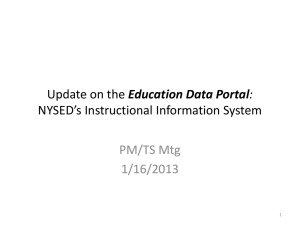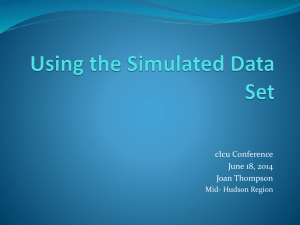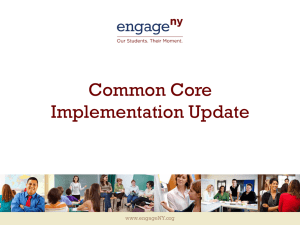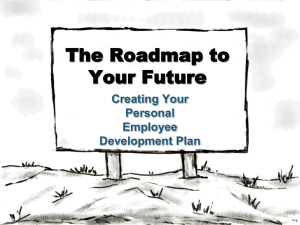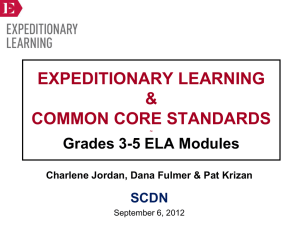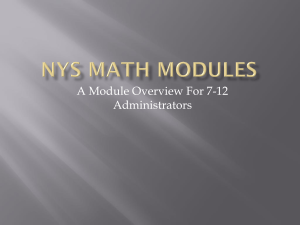Portal - OCM Boces
advertisement
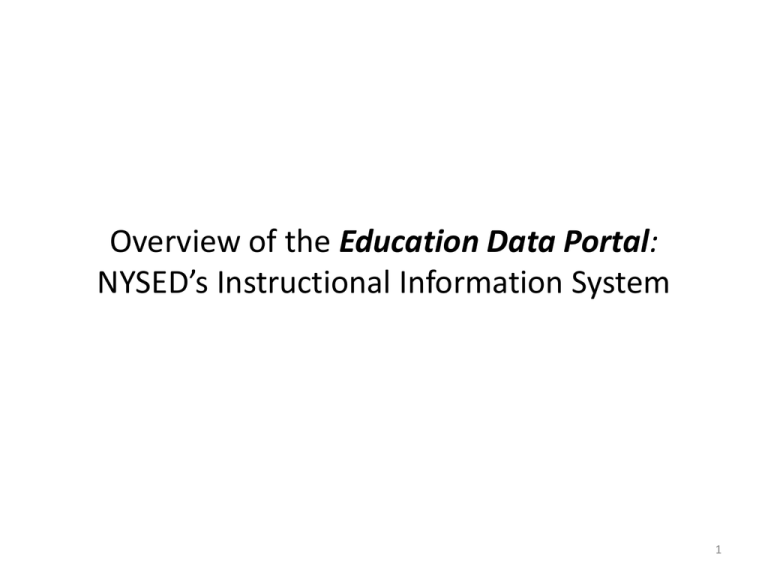
Overview of the Education Data Portal: NYSED’s Instructional Information System 1 Agenda • • • • • • • Vision and use cases Assets and architecture EDP components What LEAs need to know EDP landing page mock-ups (notional) Preliminary discussion questions for LEAs EDP resources 2 Vision 1. Make student data available to New York’s educators, students, and their families to support instruction and student learning. 2. Make curriculum and instructional resources available to New York’s educators and families to support instructional improvement and professional development. 3. Create sustainable and open technology that promotes innovation, flexibility, and choice and enables local education agencies (LEAs), schools, and regional organizations to develop or procure additional applications or new functionality more rapidly and at reduced cost. 4. Leverage emerging technology interoperability standards for education applications to remove barriers to innovation and scaling of successful tools for personalizing learning. 3 Use cases Educators use data to help identify student educational needs and have integrated access to aligned State-provided and user-generated curriculum and instructional resources. Access between data dashboards and curriculum and instructional resources should be provided within the Education Data Portal (EDP) single sign-on environment by means of intuitive navigation, access to integrated search functions, and, optionally, embedded recommendation engines. Parents (or guardians) view their child’s data and have a common framework within which to structure communications with educators. Students enrolled in grade six and above access data elements available to educators and parents as part of their preparations for college and career readiness. 4 Leveraging key assets to build the EDP Asset Description New York State’s Student Information Repository System (SIRS) NYSED operates a robust statewide data collection and repository system that ingests data from schools statewide via Regional Information Centers (RICs) and large school districts (Big 5). NYSED will leverage this system to source data to the Shared Learning Infrastructure (see below) and the EDP. NYSED’s Federated Identity Management System NYSED is building a federated solution for identity management and authentication of educators, school administrators, parents/guardians, and students to enable single-sign on to the EDP and applications within the portal. Shared Learning Infrastructure (SLI) The Shared Learning Collaborative is a not-for-profit corporation organized to develop and implement low-cost, interoperable, reusable, and secure technology assets and services that will be available to all states and districts. This Shared Learning Infrastructure (SLI) includes a shared data store and set of standardized data integration servicesthat will support the implementation of the Common Core State Standards and help states and districts provide teachers with the instructional data and tools they need to make personalized learning a reality. EngageNY.org NYSED currently operates this public website through which it provides State-sourced curricular, video, and other content. Beginning in the spring through the fall 2012, EngageNY.org will be re-built and will publish New York’s Common Core curriculum modules and videos of effective teaching practices. During the implementation of the EDP, the EngageNY.org site will be enhanced. Learning Resource Meta-data Initiative (LRMI), Common Core Taxonomy, and the Learning Registry LRMI is a protocol for marking up educational content with relevant meta-data, including the Common Core taxonomy. EDP content will be tagged using the Learning Resource Metadata Initiative protocol, and Common Core State Standards (CCSS) will be referenced using the Common Core Taxonomy. The EDP will provide enhanced search and other functionality by sending, receiving, and leveraging content metadata (including tags and ratings) to and from the Learning Registry (www.learningregistry.org). EngageNY.org will be capable of publishing all content to the Learning Registry. Further, the system will be able to subscribe to or import trusted content discoverable via the 5 Learning Registry. High level architecture for the EDP Key Federated Identity Management System Selection and License Management System (Data Dashboard Solutions) New York State, RIC, or LEA Operated Shared Learning Collaborative Statewide Data System (Level 2) Data Dashboard Solutions Vendor 1 SIRS Vendor 2 Vendor 3 Proposed TBD Vendor Contract(s) Interoperability tools Regional Data Systems (Level 1) Shared Learning Infrastructure (SLI) Content Management and Collaboration EngageNY.org (1.5/2.0) Collaboration App LRMI protocol Web Based Data Loading (Level 0) School and District Student Management Systems Course Catalog Learning Registry Node Common Core Standards Taxonomy Future 3rd Party Apps Common Core Learning Maps Content Search & Tagging 6 Key components of the EDP 1 Provide Overarching Project Services Portal •The Portal is designed to provide an easy way to navigate between web apps that are SLI-compliant. This will include apps provided by the EDP (i.e. Data Dashboards, EngageNY), apps funded and provided by the SLC (i.e. Student Data Aggregation Calculator, Student Groups Tool, etc.), and other tools to be built on the SLI by LEAs, RICS, NYSED, or vendors. •Links to a user’s applications are displayed on his or her Homepage. This page allows users to switch between web applications approved for use by NYSED through a single username or password. 2 Content Management and Collaboration Solution •Access to NYSED-sourced curricular and instructional content through a to-be-enhanced version of its EngageNY.org website. •EDP users will be able to create and curate their own content through collaboration spaces or communities; upload and share resources, and have discussions with colleagues in their school, district, or user-defined groups; find new content aligned to their profile (grades, subjects, interests); and be notified automatically of updates to the system. •Schools, districts, and clusters of schools and districts, such as networks within the New York City Department of Education (NYCDOE), and network teams throughout New York State will be able to manage their own libraries of instructional resources. 3 Data Dashboard Solutions •NYSED is contracting with three vendors - ConnectEDU, eScholar, and Pearson/Schoolnet - to provide integrated educator/parent/student Data Dashboard solutions that display student biographical, enrollment, achievement, and other relevant data in attractive and compelling ways. Each year, LEAs can choose 1 of 3 solutions that best meets their needs. Vendor contracts are pending final approval and execution by the State Comptroller. •In addition to data views, functionality includes Early Warning Indicators and Higher Education Record Exchange •Solutions may include Learning Maps and Recommendation Engines (tbd) 7 What LEAs Need to Know About the EDP Timeline • Year 1: October 2012 – September 2013 (Implementation) • LEAs select Data Dashboard Solutions for Year 2 in April/May 2013 • Year 2: October 2013 – September 2014 (EDP Launch and Operation) • LEAs select Data Dashboard Solutions for Year 2 in April/May 2013 • Year 3: October 2014 – September 2015 (Year 2 of Operations) • EDP Contracts Expire in September 2015 • Years 4 and 5 (2, one-year optional contract extensions, based on project success and available funding) Support • Training and Documentation – Electronic training manuals will be accessed via EDP; EDP vendor will deliver train-the trainer product training (in person and online) via Network Team Institutes or other venues; training will be tied to other reform initiatives including common core implementation and data-driven instruction • Help Desk and Technical Support - All tiers of end-user support will be provided by EDP vendors via phone, email, and chat • Selection/Licensing of Data Dashboards - Prior to Years 2 and 3 of the contract, DDS vendors will demonstrate their products through a mandatory Statewide webinar and at least twelve subsequent regional live demonstration events. These demonstrations will enable LEAs to select 1 of 3 Dashboards for each year. Cost • Through the RTTT grant, NYSED will fund the development, maintenance, and operation of the EDP and associated services in years 1 and 3 (and in years 4 and 5, if possible). LEAS will incur no costs to access the Portal, select and license Data Dashboard Solutions, and use and contribute to EngageNY. • To the extent that LEAs (or RICs) aim to provide supplemental data to the EDP, above and beyond data that NYSED will source from Level 2, districts may need to fund this data integration process from local SMS vendors and/or Level 1 to the Shared Learning Infrastructure. 8 A mock-up of a possible Education Data Portal homepage design (1 of 2) Sample user (dummy data) Education Data Portal Mrs. Linda Kim MY APPLICATIONS Data Dashboard EngageNY SLC Application A SLC Application B This mock-up contains dummy data only (i.e. no actual teacher or student data has been used) Application window/viewer Links to applications selected application will be viewed in window to the left. Here, EngageNY has been selected and is viewed through the application window. Applications offered via NYSED and the SLC could be accessed from this navigation bar. 9 A mock-up of a possible Education Data Portal homepage design (2 of 2) Sample user (dummy data) Education Data Portal Mrs. Linda Kim MY APPLICATIONS Data Dashboard EngageNY SLC Application A SLC Application B This mock-up contains dummy data only (i.e. no actual teacher or student data has been used) Application window/viewer Links to applications selected application will be viewed in window to the left. Here, the Data Dashboard has been selected and a class overview is viewed through the application window. Applications offered via NYSED and the SLC could be accessed from this navigation bar. 10 Preliminary questions for LEA representatives (to be discussed on Common Core Implementation Call on 11/29/12) 1) On prior calls, we heard about the importance of communicating about the EDP in a timely manner so that districts can consider the value of the EDP before making purchasing decisions for Portals, Content Management Systems, and/or Data Dashboard tools for the 2013/2014 school year. a) We will provide product demonstration in April/May 2013; however, what type of information would your district need to determine whether to leverage the EDP or continue using existing tools between now and April/May? At what time do districts begin to make these purchasing/licensing decisions? 2) In order for educators/administrators/parents/students to use the EDP’s Data Dashboards, what are the critical types of data that users need to view and analyze? How often do they need to access this data throughout the school year? 3) We aim to deliver product demonstrations in April/May 2013, enable LEAs to select Dashboard solutions over the summer, and deliver product training in August/September before users access the real, live system in October 2013. From your perspective, does this schedule make sense or would you suggest revising this approach based on other school-level activities and availability of staff? 4) What are your burning questions or concerns regarding the EDP solution and implementation approach? 11 Resources 1. Links to RFPs for the Education Data Portal: 1. Data Dashboard Solutions: http://usny.nysed.gov/rttt/rfp/ds-07/home.html 2. Content Management and System Services: http://usny.nysed.gov/rttt/rfp/ds-08/home.html 2. Link to the Shared Learning Collaborative website: http://slcedu.org/ 3. Link to EngageNY.org (NYSED’s content management website): www.EngageNY.org 4. Link to the Learning Resource Metadata Initiative’s website: www.lrmi.net 5. Link to the Learning Registry’s website: www.learningregistry.org 12
